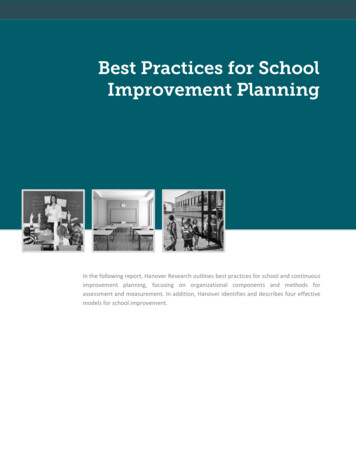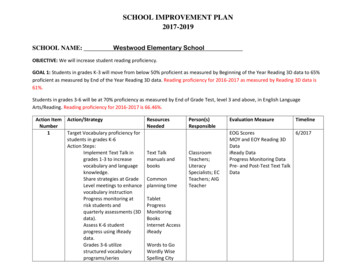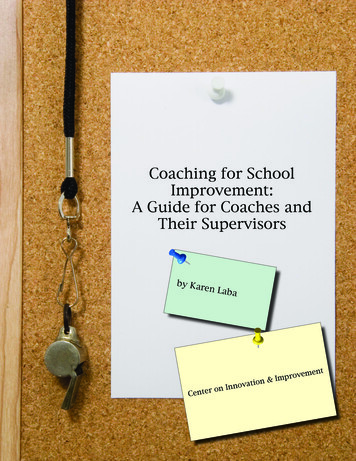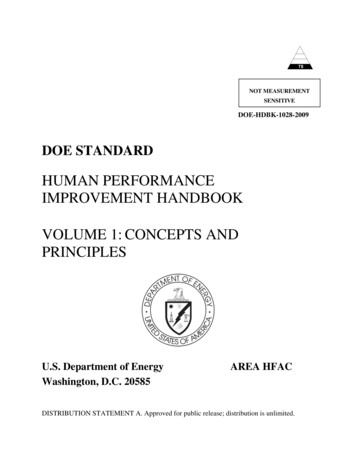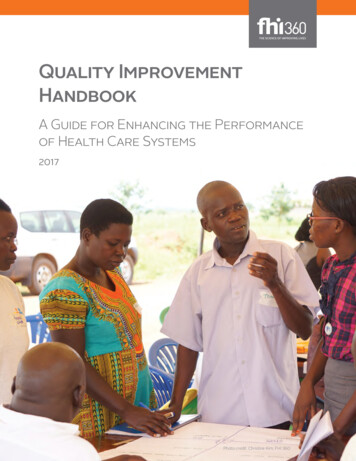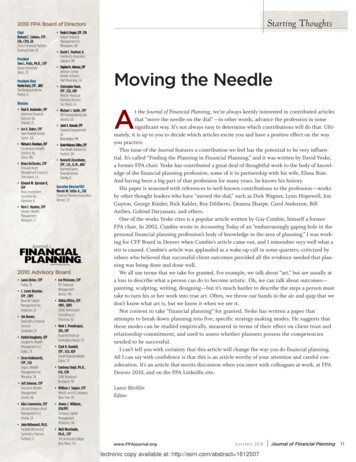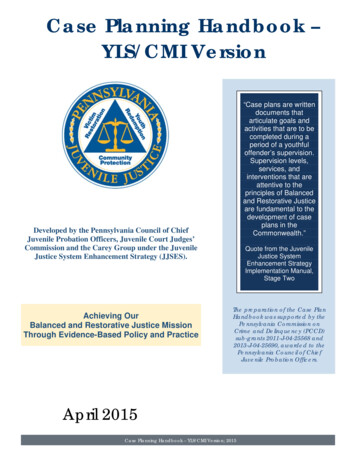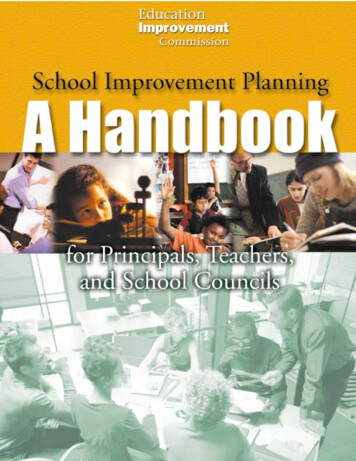
Transcription
ContentsLetter from the Commissioners . 31. Introduction . 52. What Areas Should Be Considered for Improvement? . 93. Who Are the Partners in School Improvement Planning? . 114. How Do We Begin? . 175. How Do We Create a Plan? . 396. How Do We Implement the Plan? . 477. How Do We Evaluate the Results? . 518. How Do We Keep Up the Good Work? . 55Endnotes . 57Appendices:Appendix A: School Improvement Planning Project . 59Appendix B: Sample School Improvement Plan . 61Appendix C: Characteristics of an Effective Principal . 75Appendix D: Understanding the Expectations and AchievementLevels in the Ministry of Education’s Curriculum Documents . 79Appendix E: Sample Parent Survey . 85Appendix F: Sample Text for a Pamphlet That PrincipalsCan Send to Parents with a Copy of Their School’sImprovement Plan . 91Appendix G: Additional Resources . 95SCHOOL IMPROVEMENT PLANNING HANDBOOK2
This handbook contains several pieces of information, including forms, thatpeople who are developing a school improvement plan will find useful duringthe planning process. These items are listed below.Each piece of information listed is available as a separate item on the CD-ROMversion of the handbook—as both an HTML and a PDF file. In this print versionof the handbook, these items are flagged with a CD-ROM icon.The items in the list below that are marked with asterisks (*) are also availableon the CD-ROM in word-processing formats (both Word and WordPerfect) sothat schools may adapt them to their individual needs. Consult the CD-ROMfor more information. (Please note that the CD-ROM may not work on olderMacintosh computers.)Each piece of information is also available as a separate, downloadable itemfrom the Education Improvement Commission’s website, http://eic.edu.gov.on.ca.The items are as follows: Priority for Enhancing Curriculum Delivery (pages 20 to 23) Priority for Improving the School Environment (pages 24 to 31) Priority for Increasing Parental Involvement (pages 31 to 37) * Characteristics of Effective Schools (figure 2, pages 27 to 31) * Types of Parental Involvement (figure 3, pages 35 to 36) * How Do We Involve Parents? (figure 4, page 37) * School Improvement Planning Chart (template for figure 5, page 39) Sample School Improvement Plan (appendix B, pages 61 to 73) Understanding the Expectations and Achievement Levels in the Ministry ofEducation’s Curriculum Documents (appendix D, pages 79 to 83) * Sample Parent Survey (appendix E, pages 85 to 90) * Sample Text for a Pamphlet That Principals Can Send to Parents With aCopy of Their School’s Improvement Plan (appendix F, pages 91 to 94) The Road Ahead – III: A Report on the Role of School Councils (November 1998report of the Education Improvement Commission) The Road Ahead – IV: A Report on Improving Schools Through GreaterAccountability (April 2000 report of the Education ImprovementCommission).EDUCATION IMPROVEMENT COMMISSION
Letter from theCommissionersNovember 2000The Education Improvement Commission (EIC) is an arm’s-length agency ofthe Ontario Ministry of Education. It was created in 1997 to oversee a smoothtransition to a new system of education governance for the publicly fundedelementary and secondary school systems in Ontario. It reports to and makesrecommendations to the Minister of Education.In January 1998, school boards in Ontario were reorganized. Seventy-two new district school boards were established. Many of the previously existing boardswere amalgamated, some new boards were created, and some boards remainedmuch as they had been before this date. One important outcome of the reorganization was the establishment of a new system of French-language boardsthat now spans the entire province.Four distinct school board systems now exist in Ontario: English-language district school boards English-language Catholic district school boards French-language district school boards French-language Catholic district school boards.These four distinct and equal systems share common goals and responsibilities,while the French-language and Catholic systems simultaneously protect andpromote the cultural, linguistic, and religious values that are central to theirindividual purposes.In 1999, as part of our mandate, we undertook a progress review of all 72 boardsin the province.1 In The Road Ahead – IV: A Report on Improving SchoolsThrough Greater Accountability, published at the end of the review, we statedour view that “the development and implementation of a comprehensiveaccountability framework is the single most important factor that would have thegreatest impact in improving our education system and student achievement.” 2SCHOOL IMPROVEMENT PLANNING HANDBOOK4
We concluded that we need: better information about our students’ performance better information about the factors that affect this performance, and an increased focus on improvement planning at the provincial, board, and schoollevels.In an earlier report, The Road Ahead – III: A Report on the Role of School Councils, wehad recommended that all schools develop and publish annual school improvement plans,and that the planning process include a meaningful role for school councils and parents.3To contribute to this goal, the Commission worked with 10 schools in the province todevelop and pilot a school improvement planning process that includes parents.4 Basedon this experience, we offer this handbook as a practical, “how-to” guide to schoolimprovement planning.We express our sincere thanks to the principals, teachers, parents, students, and coordinators involved in the pilot projects. They have played a most important part in thedevelopment of this handbook.Ontario is a large and diverse province. Whatever else a school improvement planningprocess needs to be, it clearly needs to reflect the unique issues and characteristicsof each school community, including the unique needs of the Catholic and French-language systems. We know that boards, schools, and improvement planning teams willwant to modify the material and processes outlined in the handbook to reflect their owncharacteristics and local circumstances.We encourage these kinds of modifications, confident in the knowledge that improvement in student performance is much more likely if schools and their communities setout in an organized, focused, inclusive, and public way to plan to improve.Our hope is that this handbook represents a significant contribution towards this goal.Dave CookeCo-chairAnn VanstoneCo-chairPeter CameronCommissionerRémi LessardCommissionerBetty Moseley-WilliamsCommissionerArlene WrightCommissionerEDUCATION IMPROVEMENT COMMISSION5
1IntroductionAll schools want their students tosucceed. But schools can only make alasting difference when they focus onspecific goals and strategies for change.School improvement planning is aprocess through which schools set goalsfor improvement, and make decisionsabout how and when these goals willbe achieved. The ultimate objective ofthe process is to improve studentachievement levels by enhancing theway curriculum is delivered, by creatinga positive environment for learning,and by increasing the degree to whichparents5 are involved in their children’slearning at school and in the home.What is a schoolimprovement plan?A school improvement plan is a roadmap that sets out the changes a schoolneeds to make to improve the level ofstudent achievement, and shows howand when these changes will be made.School improvement plans are selective: they help principals, teachers, andschool councils answer the questions“What will we focus on now?” and“What will we leave until later?” Theyencourage staff and parents to monitorstudent achievement levels and otherfactors, such as the school environment,that are known to influence studentsuccess. With up-to-date and reliableinformation about how well studentsare performing, schools are better ableto respond to the needs of students,teachers, and parents.A school improvement plan is also amechanism through which the publiccan hold schools accountable for studentsuccess and through which it canmeasure improvement. One of the firststeps—a crucial one—in developing animprovement plan involves teachers,school councils, parents, and othercommunity members working togetherto gather and analyse informationabout the school and its students, sothat they can determine what needs tobe improved in their school. As the planis implemented, schools continue togather this kind of data. By comparingthe new data to the initial informationon which the plan was based, they—and the public—can measure the success of their improvement strategies.Real change takes time. It is importantthat all partners understand this as theyenter into the school improvementplanning process. Incremental improvements are significant, and they shouldbe celebrated, but they do not constitutelasting change. School improvementSCHOOL IMPROVEMENT PLANNING HANDBOOK6
plans are therefore best designed asthree-year plans: year 1 is taken up with the planningprocess year 2 is the first year of implementation year 3 is the year in which implementation continues.During initial deliberations, or as timegoes on, schools may wish to extendtheir plan for additional years to ensurethat they maintain their focus and reachtheir goals. In any case, school improvement plans should be considered working documents that schools use tomonitor their progress over time andto make revisions when necessary toensure that the plans stay on course.In developing their school’s improvement plan, the principal, staff, schoolcouncil, parents, and other communitymembers work through a variety ofactivities focused on three areas ofpriority: curriculum delivery, schoolenvironment, and parental involvement.For each of these areas, schools establishthe following: a goal statement performance targets areas of focus implementation strategies indicators of success time lines responsibility for implementingstrategies checkpoints for status updates opportunities for revisions.Appendix B contains a sample schoolimprovement plan.EDUCATION IMPROVEMENT COMMISSION7About this handbookFor school improvement planning tobe successful, it must involve all schoolpartners. When we refer to “schools”in this handbook (“schools should ”),we mean the entire school community.The principal, as the person responsiblefor administering the school and forproviding instructional leadership, isultimately responsible for improvementplanning. But the entire school community should be actively involved in allstages of the process: planning, implementing, monitoring, and evaluatingprogress. We have therefore writtenthis handbook for principals, teachers,school councils, parents, and othercommunity members who participatein the process.The handbook is intended to be a practical guide for schools that are alreadyinvolved in the improvement planningprocess, as well as those that are justbeginning. Chapters 2 and 3 describethe areas that should be considered forimprovement and the roles that variouspartners can play in making the processa success. Chapters 4 through 8 outlinestep-by-step activities that help schoolsdevelop their first school improvementplan, implement it, evaluate its success,and revise it to ensure continuousimprovement. The appendices provideadditional resources.Each school and school communityhas unique needs and characteristics.Schools may find, as they work throughthe handbook, that they want to modifysome of the premises, steps, and activities to ensure that their final planreflects their specific needs.
Together we caneffectively makethe changesneeded toimprove studentperformance.For example, the sections on effectiveschools and the role of the principal donot reflect the centrality of the Catholicchurch and faith in the work and goalsof schools in the Catholic systems.Catholic school boards will want towork with their Church, their parishes,and members of their Catholic community to ensure that the materials andactivities used to develop improvementplans reflect their purpose.Similarly, French-language boards willwant to work with members of theFrench cultural community to adaptsections of this handbook so that theyadequately reflect the important rolethat schools in the French-languagesystems play in preserving and strengthening French language, culture, andinstitutions.Diversity is evident in a multitude ofother situations across the province.Schools in multilingual, multiculturalsettings face certain challenges uniqueto their settings, while schools in isolatedparts of the province face a completelydifferent set of challenges.All district school boards should takethe initiative and work with staff,school councils, parents, and communityrepresentatives to develop guidelinesthat will help schools modify their plansto reflect the unique cultural, linguistic,religious, and other demographicfeatures of their school communities.A CD-ROM version of this handbook isbeing distributed to each school in theprovince, along with the print version.For the convenience of those involvedin school improvement planning, severalpieces of information from the text ofthe handbook, including forms, havebeen reproduced on the CD-ROM asseparate items. Some of the items areavailable in word-processing formats(both Word and WordPerfect) so thatschools can alter them to suit theirindividual needs. These pieces of information are also available as separate,downloadable items from theEducation Improvement Commission’swebsite, http://eic.edu.gov.on.ca. A completelist of these items appears on page 2 ofthe handbook.Secondary schools play different rolesand face different challenges than elementary schools. In addition, secondaryschools have not yet completely implemented the new curriculum. Becauseour pilot projects in school improvementplanning were all with elementaryschools, we may have overlookedconditions or factors that secondaryschools will want to take into accountin their improvement planning.We anticipate that each school will adaptthe processes in this handbook to itsown needs. In several parts of the text,we have noted where such modifications would occur.SCHOOL IMPROVEMENT PLANNING HANDBOOK8
EDUCATION IMPROVEMENT COMMISSION9
2What Areas Should BeConsidered forImprovement?The overall objective of school improvement planning is an enhanced level ofstudent achievement. To effect realchange, however, the process needs tofocus on specific priorities.Student performance improves whenteachers use curriculum-delivery strategies that specifically address the needsof their students, when the school environment is positive, and when parentsare involved in their children’s education.In planning improvements, therefore,schools should establish one priority ineach of these three areas—curriculumdelivery, school environment, andparental involvement. In effect, theplanning process involves answeringthe important questions: “What will wefocus on now?” and “What will weleave until later?”Curriculum deliveryCurriculum is the foundation of theeducation system. The Ministry ofEducation has published curriculumpolicy documents that set out expectations for student learning in each gradeand subject area. “The expectations describe the knowledge and skills thatstudents are expected to develop and todemonstrate in their class work, ontests, and in various other activities onwhich their achievement is assessed.”6The policy documents also containachievement charts (“rubrics”) thathelp teachers assess the level of eachstudent’s achievement in relation to theexpectations. “The achievement levelsare brief descriptions of four possiblelevels of student achievement. Thesedescriptions, which are used along withmore traditional indicators like lettergrades and percentage marks, areamong a number of tools that teachersuse to assess students’ learning.”7To set a goal for improving the waycurriculum is delivered, principals,teachers, school councils, parents, andother community members participatingin the improvement planning processmust understand the expectations setout by the ministry and how well thestudents in their school are achievingthose expectations.Strategies to help schools set a curriculumdelivery goal are described beginningon page 20.School environmentEffective schools share a set of characteristics that add up to an environmentthat fosters student achievement.8 Bysetting goals to improve a school’senvironment, principals, teachers,school councils, parents, and otherSCHOOL IMPROVEMENT PLANNING HANDBOOK10
community members can make theirschools more effective places in whichto learn.Highly effective schools share thefollowing characteristics:We are finally onthe same team. a clear and focused vision a safe and orderly environment a climate of high expectations forstudent success a focus on high levels of studentachievement that emphasizes activities related to learning a principal who provides instructional leadership frequent monitoring of studentprogress strong home-school relations.9In assessing the effectiveness of theirown school environment, schools andtheir improvement planning partnersmay wish to add to the seven characteristics described above. For example,schools in the Catholic systems willwant to extend this list to reflect theCatholic vision of the learner, the pastoral priorities of the local parish, anddiocesan priorities. Schools in theFrench-language systems will want toconsider their role in enhancing students’understanding of French language,culture, and institutions, as well as thecentral role their school plays in theculture of their community.Strategies to help schools evaluate and seta goal for improving their environmentsare described beginning on page 24.EDUCATION IMPROVEMENT COMMISSION11Parental involvementResearch tells us that parental involvement is one of the most significantfactors contributing to a child’s successin school. When parents are involved intheir children’s education, the level ofstudent achievement increases. Studentsattend school more regularly, completemore homework in a consistent manner,and demonstrate more positive attitudestowards school. They also are morelikely to complete high school.10Parental involvement helps a childsucceed in school and later in life. Toensure parents are informed about andinvolved in their children’s education,schools must foster partnerships withparents. Because parental involvementis one of the most significant factors ina child’s success, it is crucial that allschools set a goal in their improvementplans for increasing it.Strategies to help schools understandthe needs of parents in their communitiesand set an improvement goal in this areaare described beginning on page 31.
3Who Are the Partnersin School ImprovementPlanning?Everyone involved in or interested inthe operation of schools has a role toplay in the improvement planningprocess. District school boards andsuperintendents of education playimportant roles in setting directions andin supporting and monitoring schoolimprovement plans. The most importantwork, however, takes place within theschool community itself. As we said inchapter 1, a
beginning. Chapters 2 and 3 describe the areas that should be considered for improvement and the roles that various partners can play in making the process a success. Chapters 4 through 8 outline step-by-step activities that help schools develop their first school improvement plan, implem
